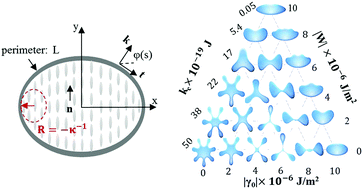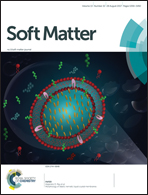Morphology of elastic nematic liquid crystal membranes
Abstract
Liquid crystalline phases found in many biological materials, such as actin, DNA, cellulose, and collagen can be responsible for the deformation of cell membranes. In this paper, cell membrane deformation is investigated through the coupling between liquid crystal anisotropy and membrane bending elasticity. The generalized shape equation for anisotropic interfaces, which resort to the Cahn–Hoffman capillarity vector, the Rapini–Papoular anchoring energy, and the Helfrich elastic energy, is applied to gain insight into the deformation of closed liquid crystal membranes. This study presents a general morphological phase diagram of membrane surface patterns, in which two characteristic regimes of membrane shapes can be classified with respect to the most dominant factor between liquid crystal anisotropy and bending elasticity. To that end, we consider a 2D nematic liquid crystal droplet immersed in a isotropic phase in the presence of an interfacial layer of surfactants, which leads to an additional elastic contribution to the free energy of the system. The presented results indicate that, depending on the bending elasticity of the cell membrane, the liquid crystal might be able to deform the cell, thereby resulting in anisotropic asymmetric shapes. As liquid crystal anisotropy dominates the bending elasticity, spindle-like or tactoid shapes, which are extensively observed in experiments, can be formed. The findings provide a foundational framework to better understand membrane topologies in living soft matters. Furthermore, the coupling between order and curvature of membranes shed new light into the design of novel functional soft materials.



 Please wait while we load your content...
Please wait while we load your content...